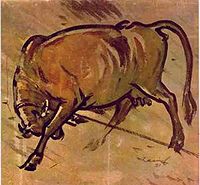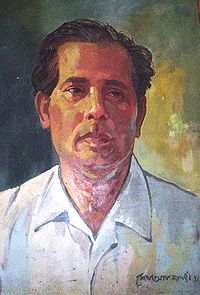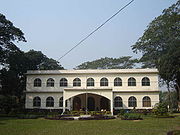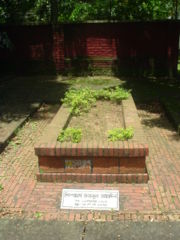
Zainul Abedin
Encyclopedia
Zainul Abedin (December 29, 1914 – May 28, 1976) was nitially a painter of India and became famous in 1944 with his Famine Series paintings of 1943; and after partition he moved to Pakistan; and finally when Bangladesh was created in 1971, he was rightly considered the founding father of Bangladeshi Art. Like many of his contemporaries, His paintings on the Bengal
famine of 1940s is probably his most characteristic work. In Bangladesh, he is referred with honor as Shilpacharya (Great Teacher of the Arts) in Bangladesh.
, Bengal
, on December 29, 1914. Much of his childhood was spent near the scenic banks of the Brahmaputra River
. The Brahmaputra would later appear in many of his paintings and be a source of inspiration all throughout his career. In 1933, Abedin was admitted to Calcutta Government Art School in Calcutta. He joined the faculty of the same school after his education was completed. A series of watercolours that Zainul did as his tribute to the Brahmaputra River earned him the Governor's Gold Medal in an all-India exhibition in 1938. This award gave Abedin the confidence to create his own visual style.




 The man-made Great Bengal Famine of 1943
The man-made Great Bengal Famine of 1943
moved Zainul deeply. He created his famine painting set, which, when exhibited in 1944, brought him even more critical acclaim.
He was an influential member of the Calcutta Group
of progressive artists and was friends with Shahid Suhrawardy and Ahmed Ali of the Progressive Writer's Movement.
movement that finally made the creation of Bangladesh possible. He was in the forefront of the cultural movement to re-establish the Bengal
i identity, marginalised by the Pakistan government. In 1969, Abedin painted a scroll using Chinese ink, watercolour and wax named Nobanno
. This was to celebrate the ongoing non-cooperation movement.
, near Dhaka
, and Zainul Abedin Sangrahashala, a gallery of his own works in Mymensingh
. Abedin developed lung cancer and died on May 28, 1976 in Dhaka
. Two faces was his last painting, completed shortly before his death.
In 1982, 17 of the 70 pictures housed in Zainul Abedin Sangrahashala were stolen. Only 10 were later recovered.His famous painting "Study of a Crow" (Ink Wash) in the collection of Professor Ahmed Ali is listed in the book 'Arts in Pakistan" by Jalaluddin Ahmed, 1952, including an exclusive monologue on him published by FOMMA, Karachi, along with his many Famine Series paintings of 1943.
Bengal
Bengal is a historical and geographical region in the northeast region of the Indian Subcontinent at the apex of the Bay of Bengal. Today, it is mainly divided between the sovereign land of People's Republic of Bangladesh and the Indian state of West Bengal, although some regions of the previous...
famine of 1940s is probably his most characteristic work. In Bangladesh, he is referred with honor as Shilpacharya (Great Teacher of the Arts) in Bangladesh.
Early life and education
Zainul Abedin was born in KishoreganjKishoreganj
Kishoreganj District with an area of 2688.62 sq km, is bounded by Netrokona and Mymensingh districts on the north, Narsingdi district on the southwest and brahmanbaria district on the southeast, sunamganj and habiganj districts on the east, gazipur and Mymensingh districts on the west...
, Bengal
Bengal
Bengal is a historical and geographical region in the northeast region of the Indian Subcontinent at the apex of the Bay of Bengal. Today, it is mainly divided between the sovereign land of People's Republic of Bangladesh and the Indian state of West Bengal, although some regions of the previous...
, on December 29, 1914. Much of his childhood was spent near the scenic banks of the Brahmaputra River
Brahmaputra River
The Brahmaputra , also called Tsangpo-Brahmaputra, is a trans-boundary river and one of the major rivers of Asia. It is the only Indian river that is attributed the masculine gender and thus referred to as a in Indo-Aryan languages and languages with Indo-Aryan influence...
. The Brahmaputra would later appear in many of his paintings and be a source of inspiration all throughout his career. In 1933, Abedin was admitted to Calcutta Government Art School in Calcutta. He joined the faculty of the same school after his education was completed. A series of watercolours that Zainul did as his tribute to the Brahmaputra River earned him the Governor's Gold Medal in an all-India exhibition in 1938. This award gave Abedin the confidence to create his own visual style.
Famine paintings





Bengal famine of 1943
The Bengal famine of 1943 struck the Bengal. Province of pre-partition India. Estimates are that between 1.5 and 4 million people died of starvation, malnutrition and disease, out of Bengal’s 60.3 million population, half of them dying from disease after food became available in December 1943 As...
moved Zainul deeply. He created his famine painting set, which, when exhibited in 1944, brought him even more critical acclaim.
He was an influential member of the Calcutta Group
Calcutta Group
The Calcutta Group was the first group of modern artists in India, formed in 1943 in Kolkata. Its leading members included the sculptor Pradosh Das Gupta and the painters Paritosh Sen, Gopal Ghose, Nirode Mazumdar and Zainul Abedin...
of progressive artists and was friends with Shahid Suhrawardy and Ahmed Ali of the Progressive Writer's Movement.
Liberation movement
Abedin was involved in the Bangladesh liberation warBangladesh Liberation War
The Bangladesh Liberation War was an armed conflict pitting East Pakistan and India against West Pakistan. The war resulted in the secession of East Pakistan, which became the independent nation of Bangladesh....
movement that finally made the creation of Bangladesh possible. He was in the forefront of the cultural movement to re-establish the Bengal
Bengal
Bengal is a historical and geographical region in the northeast region of the Indian Subcontinent at the apex of the Bay of Bengal. Today, it is mainly divided between the sovereign land of People's Republic of Bangladesh and the Indian state of West Bengal, although some regions of the previous...
i identity, marginalised by the Pakistan government. In 1969, Abedin painted a scroll using Chinese ink, watercolour and wax named Nobanno
Nobanno
Nobanno is the festival of harvest in Bengal. The word translates as "New Rice". The festival takes place in the month of Agrohayon or Aghran of the Bangla Calendar. Festivities include making traditional cakes named "pitha"....
. This was to celebrate the ongoing non-cooperation movement.
Post-independence era
In 1975, he founded the Folk Art Museum at SonargaonSonargaon
Sonargaon is the ancient capital of Isa Khan's kingdom in Bengal. It is located near the current-day city of Narayanganj, Bangladesh....
, near Dhaka
Dhaka
Dhaka is the capital of Bangladesh and the principal city of Dhaka Division. Dhaka is a megacity and one of the major cities of South Asia. Located on the banks of the Buriganga River, Dhaka, along with its metropolitan area, had a population of over 15 million in 2010, making it the largest city...
, and Zainul Abedin Sangrahashala, a gallery of his own works in Mymensingh
Mymensingh
Mymensingh , pronounced moy-mon-shing-haw, is a city of Bangladesh situated on the river Brahmaputra. It is the headquarters of the administrative unit Mymensingh District. Mymensingh is the anglicized pronunciation of the original name Momenshahi, referring to a ruler called Momen Shah. The cadet...
. Abedin developed lung cancer and died on May 28, 1976 in Dhaka
Dhaka
Dhaka is the capital of Bangladesh and the principal city of Dhaka Division. Dhaka is a megacity and one of the major cities of South Asia. Located on the banks of the Buriganga River, Dhaka, along with its metropolitan area, had a population of over 15 million in 2010, making it the largest city...
. Two faces was his last painting, completed shortly before his death.
In 1982, 17 of the 70 pictures housed in Zainul Abedin Sangrahashala were stolen. Only 10 were later recovered.His famous painting "Study of a Crow" (Ink Wash) in the collection of Professor Ahmed Ali is listed in the book 'Arts in Pakistan" by Jalaluddin Ahmed, 1952, including an exclusive monologue on him published by FOMMA, Karachi, along with his many Famine Series paintings of 1943.

